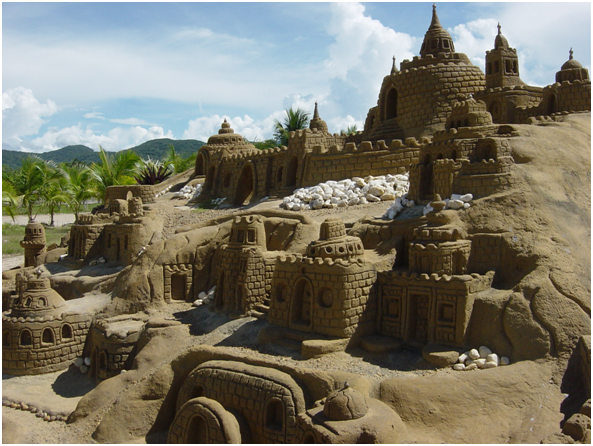
(Fortaleza construida con la arena del local). Family photo @alfceli
Hello dear friends of architecture + design and other communities that accompany us, today I want to rediscover my good memories of when I was a child, which involve a new look at the constructions that all of us to one degree or another made with the sands of the beaches. As a child we always spent Holy Week on some paradisiacal islands located in the Caribbean Sea, off the coast of Venezuela in the Falcón state, called keys in the Morrocoy National Park.
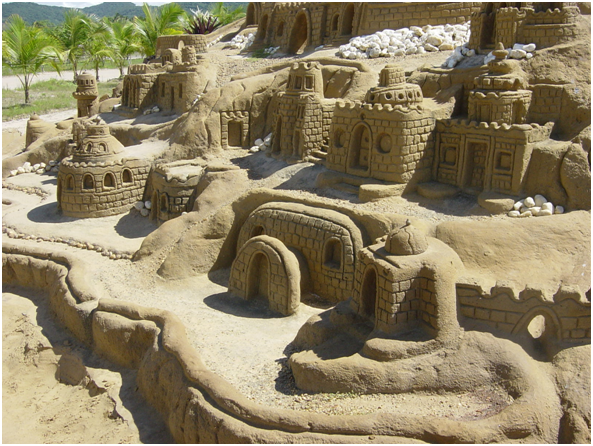
In this post, I want to share with you some family photos taken of an impressive work built in sand, on the beaches of the natural Spa "Aguas de Moisés" in the Sucre state of Venezuela, accompanied by other photos taken from the internet that show the variety of works that can be built with this abundant material and with the skill, dexterity, patience and creativity that the finished products reflect. Unfortunately none of these works can no longer be seen, because the weather, the atmospheric conditions and the proximity to the sea have made them an ephemeral art. Fortunately, the art of photography helps us to save many of these works of art and architecture. I think it can be said, without being outrageous, that sand structures are a brilliant combination of architectural design, engineering and art.
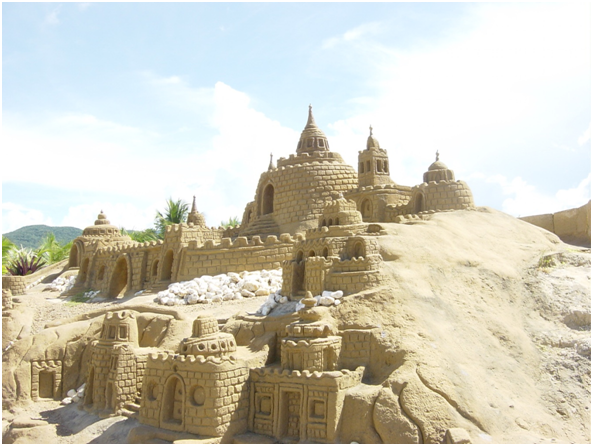
Currently there are international competitions for the construction of different types of figures in various countries of the world, it is worth highlighting those of Rorschach in Switzerland, Søndervig in Denmark, Howe Park, Windsor, New South Wales in Australia, Jelgava in Latvia, multiple in the United States of America and several beaches in Brazil.
What I have found with amazement and at the same time astounded is that building or designing figures of all kinds with the sand of the sea is no longer just child's play, because, with skill, technique and patience, plus a large amount of sand, they are achieved make impressive constructions for personal delight and those who see them. I have found that a large figure, such as a castle, needs around 5-10 tonnes of sand, while a sculpture about two or three meters high can use a lot more and may need a couple of weeks, or even more, of work.
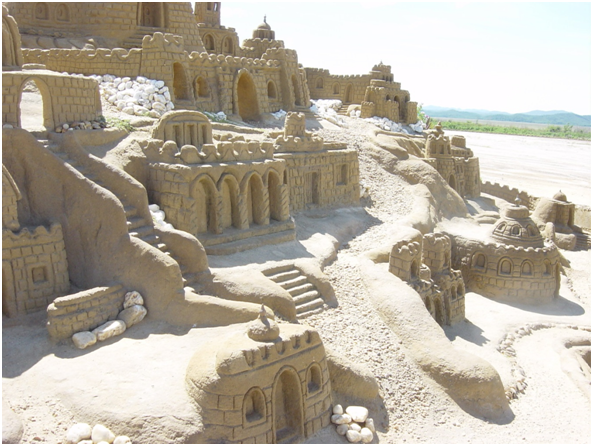
Hands, a chute and a small weeder are no longer enough, to achieve these wonders of works, now a complete set of tools is needed, similar to that used by sculptors, a set of spatulas of various shapes and sizes that are used to give shape the work, pipes of different sizes, a good shovel and wheelbarrow to move the sand, tubes to blow and remove the excess sand, a set of brushes that allow the removal of the remains of sand from the holes made in the figures and finally a rake to make the surfaces around the work uniform.
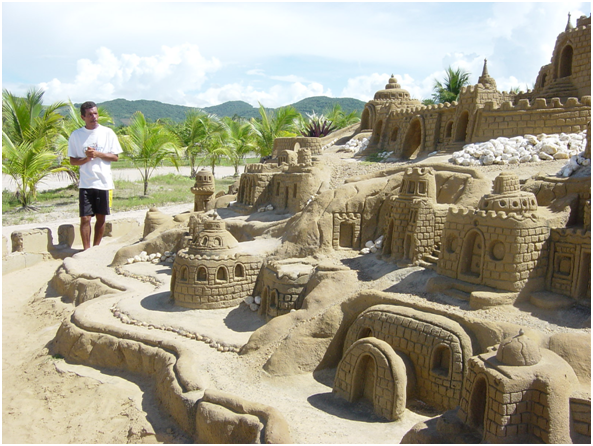
Some use their own homemade tools such as knives, spoons of different sizes that allow them, without much effort, to make convex shapes, including those used to serve frozen ice cream; combs and flat bars that are used to make grooves. The most ingenious resort to bottomless cubes or other molds of different geometric shapes cut from pieces of tubes in PVS that facilitates and lightens the construction and allows them to quickly create towers and battlements of different shapes.
On the other hand, some builders can be observed spraying finished structures with a solution of water and water-based glue, which forms a thin insulating layer from humidity, to preserve them so that the works last a little more than expected.
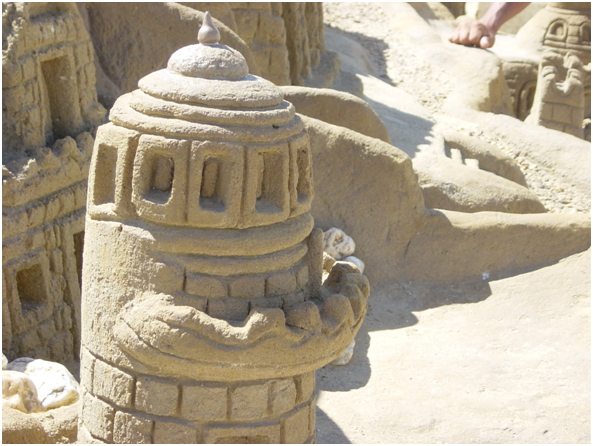
Doing a little bibliographic research, I was able to find that it is not an easy task to build any figure, of certain proportions, that you want to last a bit over time. Some secrets have to do with keeping the figure well damp with seawater, both day and night, well compact, since dryness would mean the death, before being born, of what you want to build; On the other hand, it is necessary to make a mantle or foundation thick enough to support the structure. If these two variables can be managed: humidity and compaction, the surface of the structure becomes more durable, allowing the sandy material to be more malleable.
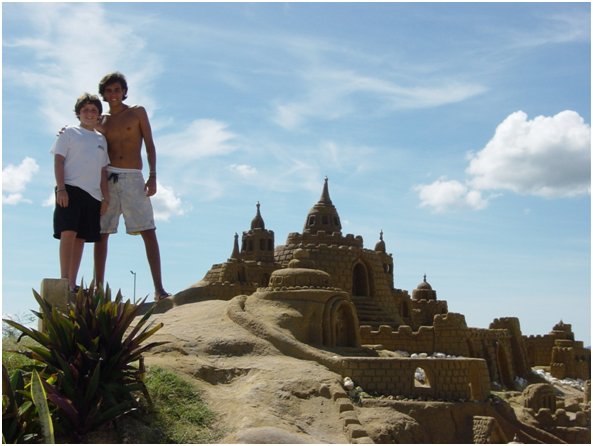
Matthew Robert Bennett, a specialist in Environmental and Geographical Sciences in England, says: “The more angular the sand grains, the better they will come together and the more the sand has rolled, the rounder it will be. In this sense, the best are microscopic pieces of shells because the finer they are, the more water they can hold. Water is very important." [This tells science on how to build the perfect sand castle Matthew Robert Bennett. https://magnet.xataka.com/un-mundo-fascinante/esto-dice-la-ciencia-sobre-como-construir-el-castillo-de-arena-perfecto].
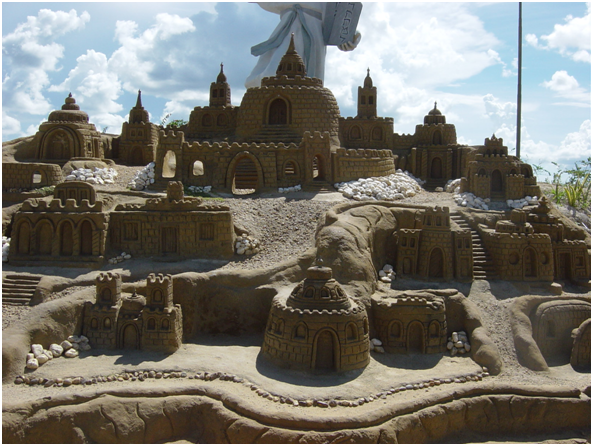
On the other hand, He gives us a mathematical formula to calculate the amount of water needed to build a perfect sand castle: one bucket of water for eight buckets of dry sand, that is (1 x water = 0.125 x sand). Finally, a useful tip is to wear gloves, especially on beaches where the sand has too much salt.
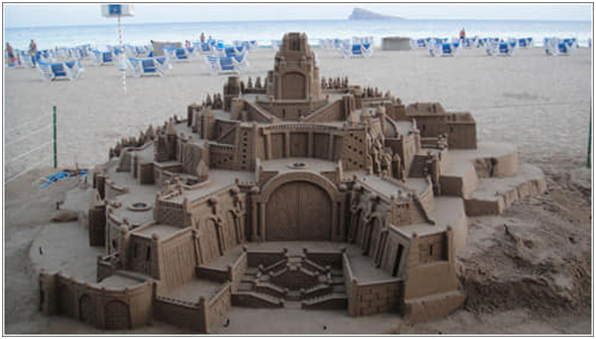
Consulted bibliography:
*Castillos en la Arena; desata tu imaginación en la playa:
http://www.fondear.org/infonautic/Hombre_y_Mar/Actividades_Deportes/Castillos-Arena/Castillos-Arena.asp
*Bennett, Matthew Robert: Esto dice la ciencia sobre cómo construir el castillo de arena perfecto. https://magnet.xataka.com/un-mundo-fascinante/esto-dice-la-ciencia-sobre-como-construir-el-castillo-de-arena-perfecto
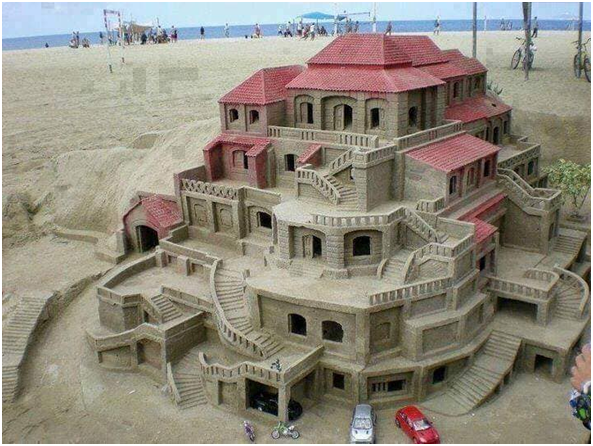
Hola estimados amigos de architecture+design y de otras comunidades que nos acompañan, hoy quiero redescubrir mis buenos recuerdos de cuando era un niño, que involucran una nueva mirada a las construcciones que todos en un grado u otro hacíamos con las arenas de las playas. De niño pasábamos siempre la Semana Santa en unas islas paradisiacas situadas en el mar Caribe, frente a las costas de Venezuela en el estado Falcón, llamadas cayos en el parque nacional Morrocoy.
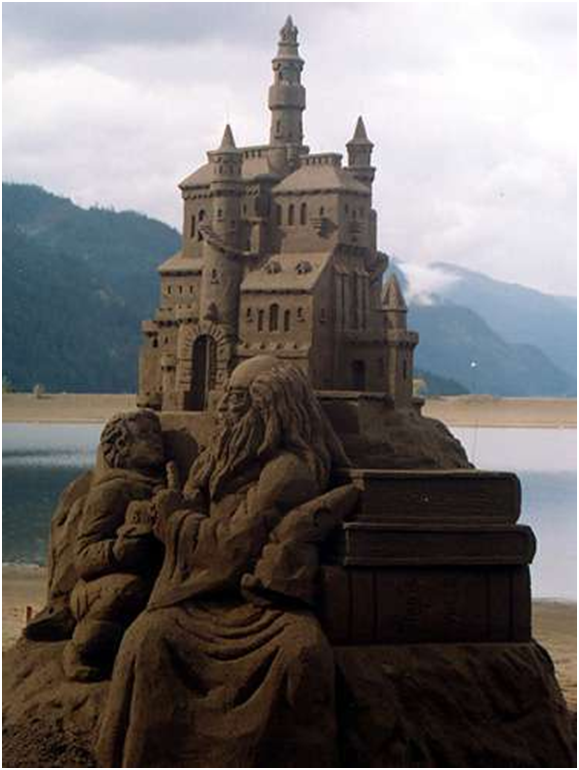
En este post, quiero compartir con ustedes algunas fotos familiares tomadas de una impactante obra construida en arena, en las playas del Spa natural “Aguas de Moisés” en el estado Sucre de Venezuela, acompañadas de otras fotos sacadas de internet que muestran la variedad de obras que se pueden construir con este abundante material y con la habilidad, destreza, paciencia y creatividad que reflejan los productos acabados. Lamentablemente ninguna de estas obras ya no es posible ver, pues el tiempo, las condiciones atmosféricas y las cercanías con el mar han hecho de ellas un arte efímero. Afortunadamente el arte de la fotografía sirve para que podamos guardar muchas de estas obras de arte y arquitectura. Creo que se puede decir, sin que ello sea una barrabasada, que las estructuras en arena son una combinación brillante de diseño arquitectónico, ingeniería y arte.
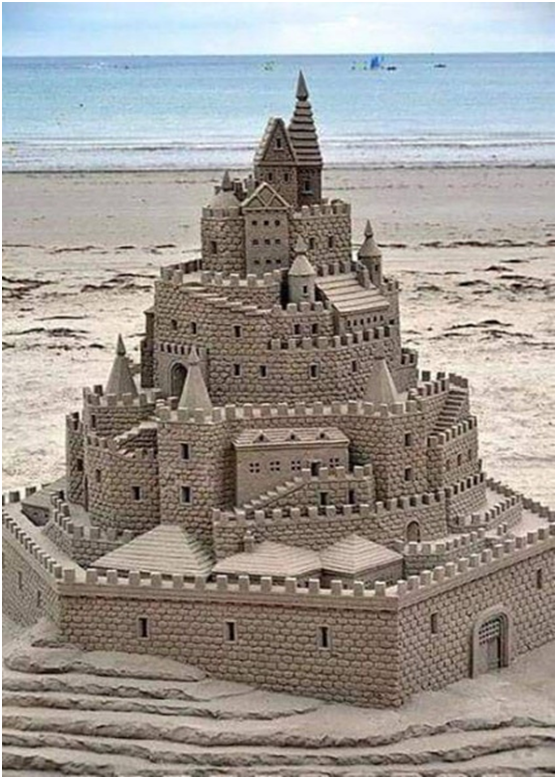
En la actualidad existen competencias internacionales para la construcción de distintos tipos de figuras en varios países del mundo, vale destacar las de Rorschach en Suiza, Søndervig en Dinamarca, Howe Park, Windsor, Nueva Gales del Sur en Australia, Jelgava en Letonia, múltiples en los Estados Unidos de América y varias playas de Brasil.
Lo que he encontrado con asombro y a la vez maravillado es que construir o diseñar figuras de todo tipo con la arena del mar ya no es sólo un juego de niños, pues, con destreza, técnica y paciencia, más gran cantidad de arena, se logran hacer impactantes construcciones para deleite personal y de los que las ven. He descubierto que una figura grande, como un castillo, necesita alrededor de entre 5 y diez toneladas de arena, mientras que una escultura de unos dos o tres metros de altura puede usar mucho más y puede necesitar un par de semanas, e inclusive más, de trabajo.
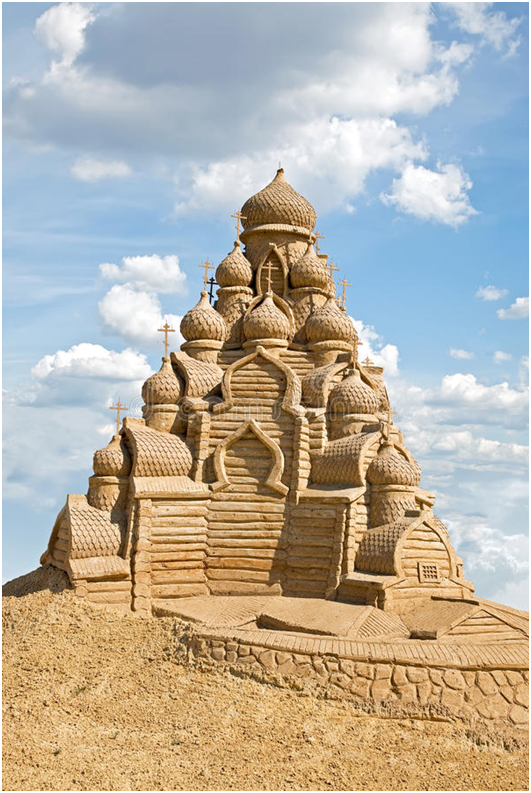
Ya no bastan las manos, un tobo y una pequeña escardilla, para lograr estas maravillas de obras, ahora se necesita un completo set de herramientas, similar al que usan los escultores, un conjunto de espátulas de varias formas y tamaños que se utilizan para dar forma a la obra, tobos de diversos tamaños, una buena pala y carretilla para trasladar la arena, tubos para soplar y quitar el arena sobrante, un juego de brochas que permitan el retiro de los restos de arena de los huecos hechos en las figuras y por último un rastrillo para dejar uniforme las superficies de los alrededores de la obra.
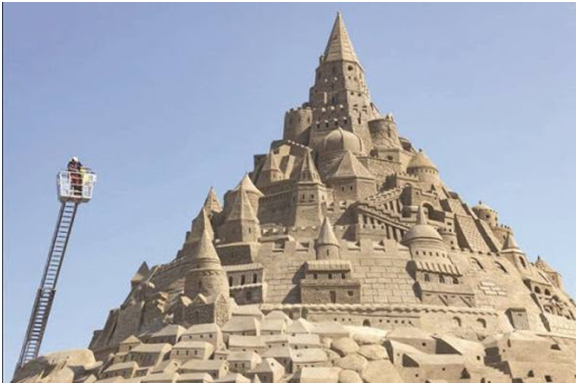
Algunos utilizan sus propias herramientas caseras como cuchillos, cucharas de distintos tamaños que les permiten, sin mayor esfuerzo, hacer formas convexas, incluyendo las que se utilizan para servir el helado congelado; peines y pletinas que se usan para hacer estriados. Los más ingeniosos recurren a cubos sin fondo u otros moldes de distintas formas geométricas cortados de pedazos de tubos en PVS que facilita y aligera la construcción y permitiéndoles crear rápidamente torres y almenas de distintas formas.
Por otra parte, se puede observar a algunos constructores rociar las estructuras, ya terminadas, con una solución de agua y pegamento a base de agua, la cual forma una delgada capa aislante de la humedad, para conservarlas a fin de que las obras duren un poco más de lo esperado.
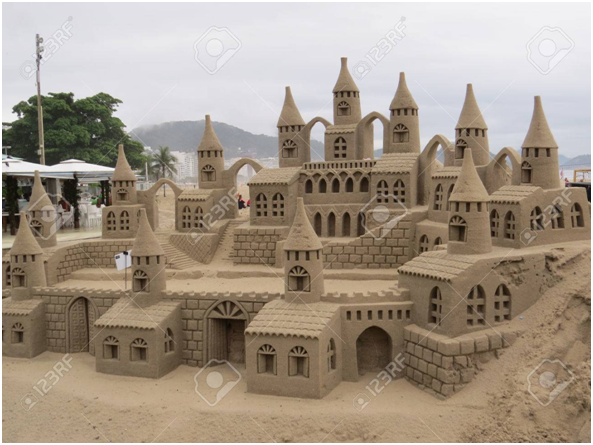
Haciendo una pequeña investigación bibliográfica, pude encontrar que no es tarea fácil construir cualquier figura, de ciertas proporciones, que se quiere perdure un poco en el tiempo. Algunos secretos tienen que ver con mantener la figura bien humedad con el agua de mar, tanto de día como de noche, bien compacta, pues la sequedad significaría la muerte, antes de nacer, de lo que se quiere construir; por otra parte, es menester hacer un manto o cimiento lo suficientemente grueso para que soporte la estructura. Si se logra manejar esas dos variables: humedad y compactación, la superficie de la estructura se hace más duradera permitiendo que el material arenoso sea más maleable.
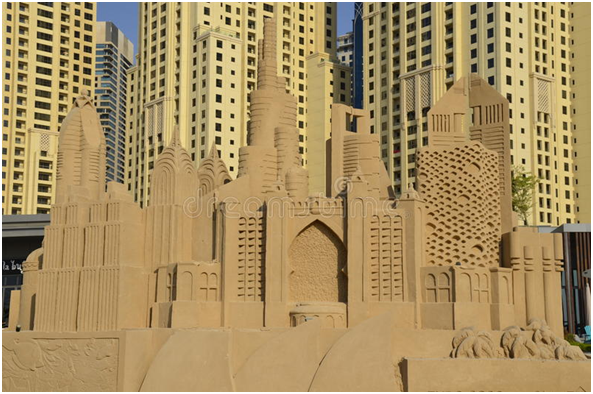
Matthew Robert Bennett, especialista en Ciencias Ambientales y Geográficas en Inglaterra, afirma que: “Cuanto más angulares sean los granos de arena, mejor se juntarán y cuanto más haya rodado el grano de arena, más redondo será. En este sentido, lo mejor son los trozos microscópicos de conchas porque cuanto más finos sean, podrán retener más agua. El agua es muy importante.” [Esto dice la ciencia sobre cómo construir el castillo de arena perfecto Matthew Robert Bennett. https://magnet.xataka.com/un-mundo-fascinante/esto-dice-la-ciencia-sobre-como-construir-el-castillo-de-arena-perfecto].
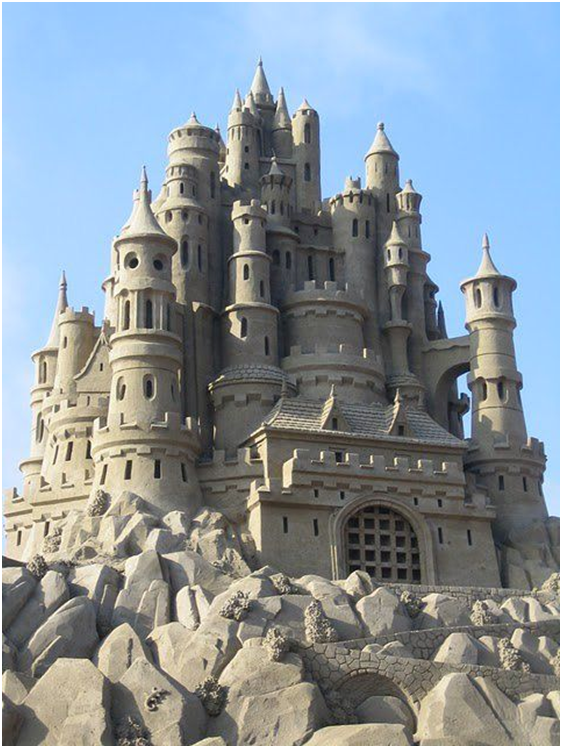
Por otra parte, nos da una fórmula matemática para calcular la cantidad de agua necesaria para construir un castillo de arena perfecto: un cubo de agua por ocho cubos de arena seca, es decir (1 x agua = 0,125 x arena). Por último, un consejo útil es el de usar guantes, sobre todo en las playas donde la arena tiene demasiada sal.
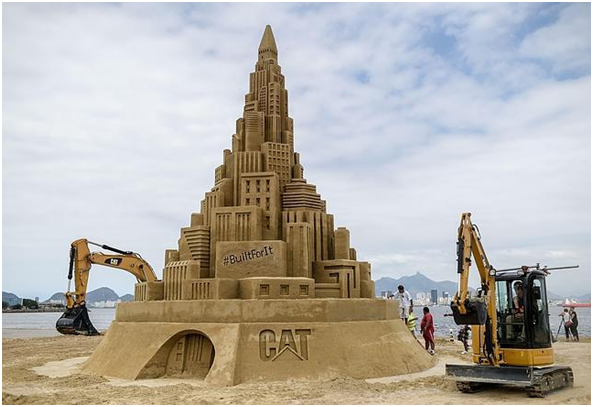
Bibliografía consultada:
*Castillos en la Arena; desata tu imaginación en la playa:
http://www.fondear.org/infonautic/Hombre_y_Mar/Actividades_Deportes/Castillos-Arena/Castillos-Arena.asp
*Bennett, Matthew Robert: Esto dice la ciencia sobre cómo construir el castillo de arena perfecto. https://magnet.xataka.com/un-mundo-fascinante/esto-dice-la-ciencia-sobre-como-construir-el-castillo-de-arena-perfecto
Your content has been voted as a part of Encouragement program. Keep up the good work!
Use Ecency daily to boost your growth on platform!
Support Ecency
Vote for Proposal
Delegate HP and earn more
Hello @besamu, this is a very interesting topic.
I agree it is not an easy task and is an art form that takes considerable skill and technique. I was able to see the sand skyscrapers at the Dubai Marina. Luckily it rains there only twice or thrice a year so they can keep this in tact all year round.
Dear discoveringarni, it is good that you were lucky enough to see in person the sand skyscrapers in the Dubai Marina, Obviously the almost no rain helps to keep the structure in time, I just wonder if it is not a kind of slavery having to keep it moist for such a long time so that it does not deteriorate quickly. Unless it were not true that it is necessary to keep it moist for its preservation, in such a dry environment. Here, in the tropics, I think it would be quite difficult. Thank you for your comment. Have a nice week.
I'm guessing the sandcastle stayed there briefly unless I'm wrong, because in Dubai they change the entire landscaping throughout the city every season. People get bored easily with what they see so they continue to change. I agree it's quite difficult to maintain in the tropics.
Woah! Those are absolutely amazing! You can even see the amount of detail the artists put into their work, it definitely is another form of art 😃 thank you for sharing such wonderful creations!

https://d.buzz
Hello ilovewintergem, it was a pleasure to share these creations in sea sand, especially the sand castle of Las Aguas de Moises in Sucre.-Venezuela. Thank you very much for your comment. Happy week
Greetings Benjamin. Oh wow, who doesn't get fascinated with sandcastles? Any kid and adult would surely be amazed at the creative sculpting talent it takes to build these artistic masterpieces. Just imagine the patience to build one of these. It's definitely a wonderful sight along the refreshing beaches and would entice our playful spirits to indulge in building more of these scaled models as well. Thank you @besamu for sharing your remarkable memories of these interesting creations!
Dear storiesoferne, as always your comments are very successful and stimulating. Although I was born in a city without beaches, since we were little we were taken to nearby beaches and we had a lot of fun making small figures with the sand. I hope to make a post with the beaches of western Venezuela where there are some paradisiacal sites. Have a very good week
Architecture Brew #31. Congratulations!Well done @besamu! We're happy to inform you that this publication was specially curated and awarded RUNNER-UP in
Subscribe to Architecture+Design, an OCD incubated community.